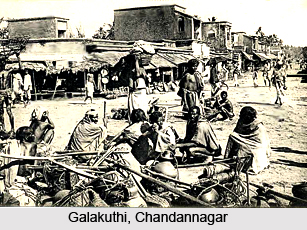 History of Chandannagar traces back to the year 1673, when it was a French colony in India. French colonization occurred immediately after the French were granted permission to install a trading post on the right banks of Hooghly River by the Nawab of Bengal, Ibrahim Khan. During that period, the province of Bengal belonged to the Mughal Empire. Chandannagar later became a French settlement in the year 1688 and Dupleix was declared the new governor of this city during 1730. It is said that under the supervision of Francois Dupleix, over 2000 brick houses were constructed in the town and maritime trade started flourishing. Till a particular period of time, Chandannagar was a significant centre which promoted European commerce in the province of Bengal.
History of Chandannagar traces back to the year 1673, when it was a French colony in India. French colonization occurred immediately after the French were granted permission to install a trading post on the right banks of Hooghly River by the Nawab of Bengal, Ibrahim Khan. During that period, the province of Bengal belonged to the Mughal Empire. Chandannagar later became a French settlement in the year 1688 and Dupleix was declared the new governor of this city during 1730. It is said that under the supervision of Francois Dupleix, over 2000 brick houses were constructed in the town and maritime trade started flourishing. Till a particular period of time, Chandannagar was a significant centre which promoted European commerce in the province of Bengal.
In the year 1756, a violent battle took place between Great Britain and France. During this point of time, Admiral Charles Watson of the British Navy as well as Robert Clive, of the British English East India Company bombed and conquered Chandannagar on 23rd March, 1757. Thereafter, the fortifications of this beautiful town were destroyed and it gradually began losing its importance as a major spot of commercial and business activities. This was due to the fact that it started being overshadowed by the city of Kolkata, which was nearby. During 1763, the French were able to regain administrative control of the region of Chandannagar before it was again recaptured by the British in Napoleanic Wars, in about 1794. However, it was again restored back to the French in the year 1816 and it was ruled as a portion of French India. This continued till 1950 and Chandannagar remained under the jurisdiction of the governor general in Pondicherry. The industrial significance of this region faded by 1900 and it started developing from a silent suburb of Kolkata to a town bustling with several sophisticated residences along the riverside.
Following the independence of India from the British Raj in the year 1947, particularly during June 1948, it was discovered that around 97 percent of the regional inhabitants of Chandannagar desired their birthplace to be a portion of India. The Indian government was permitted by the French to exercise de facto administrative control over Chandannagar in May 1950. However, it was only on 2nd February, 1951 that the area was officially handed over to India, as part of its territories. During 9th June, 1952, the De Jure transfer occurred and on 2nd October, 1955, Chandannagar was absorbed into the eastern Indian state of West Bengal.



















